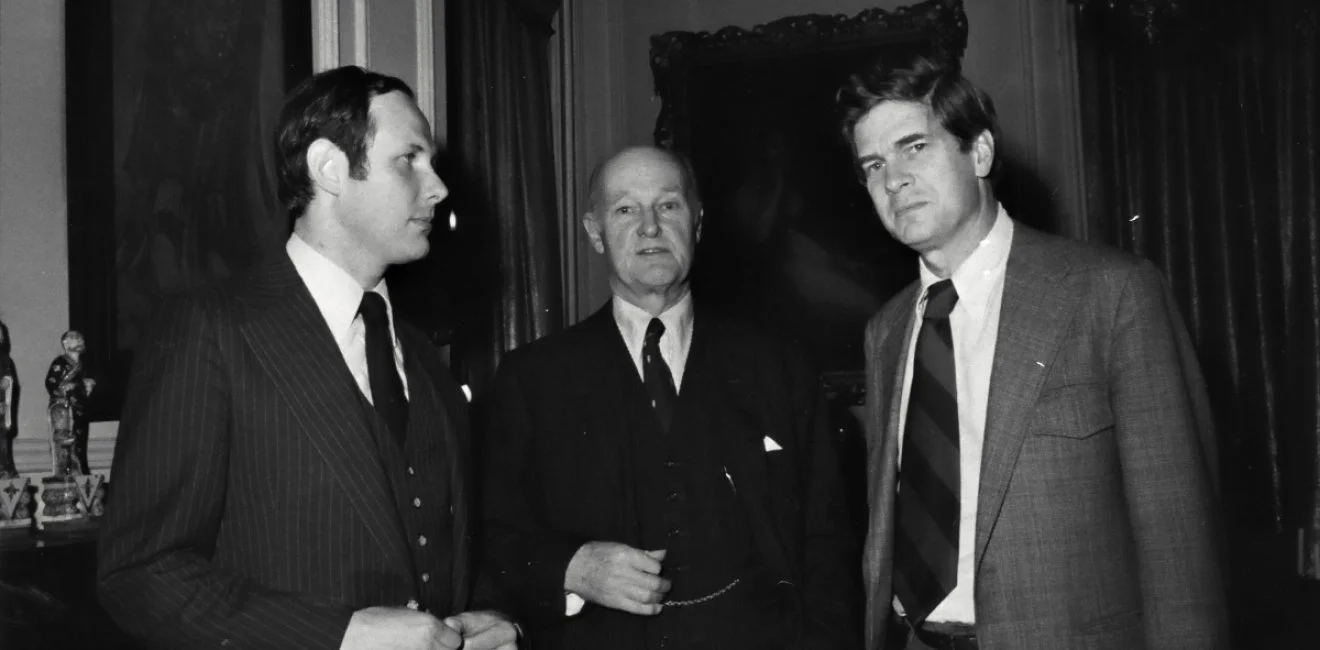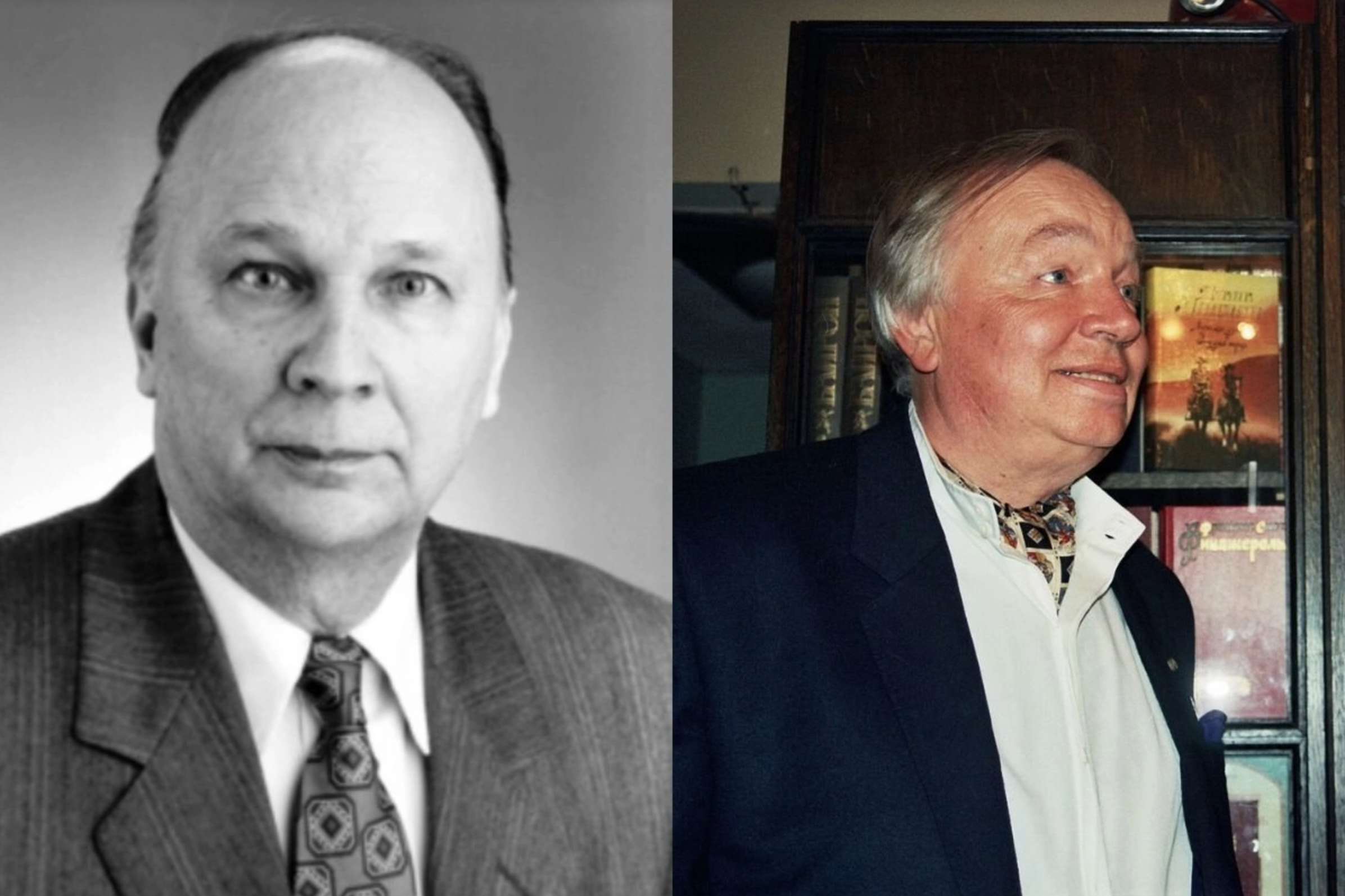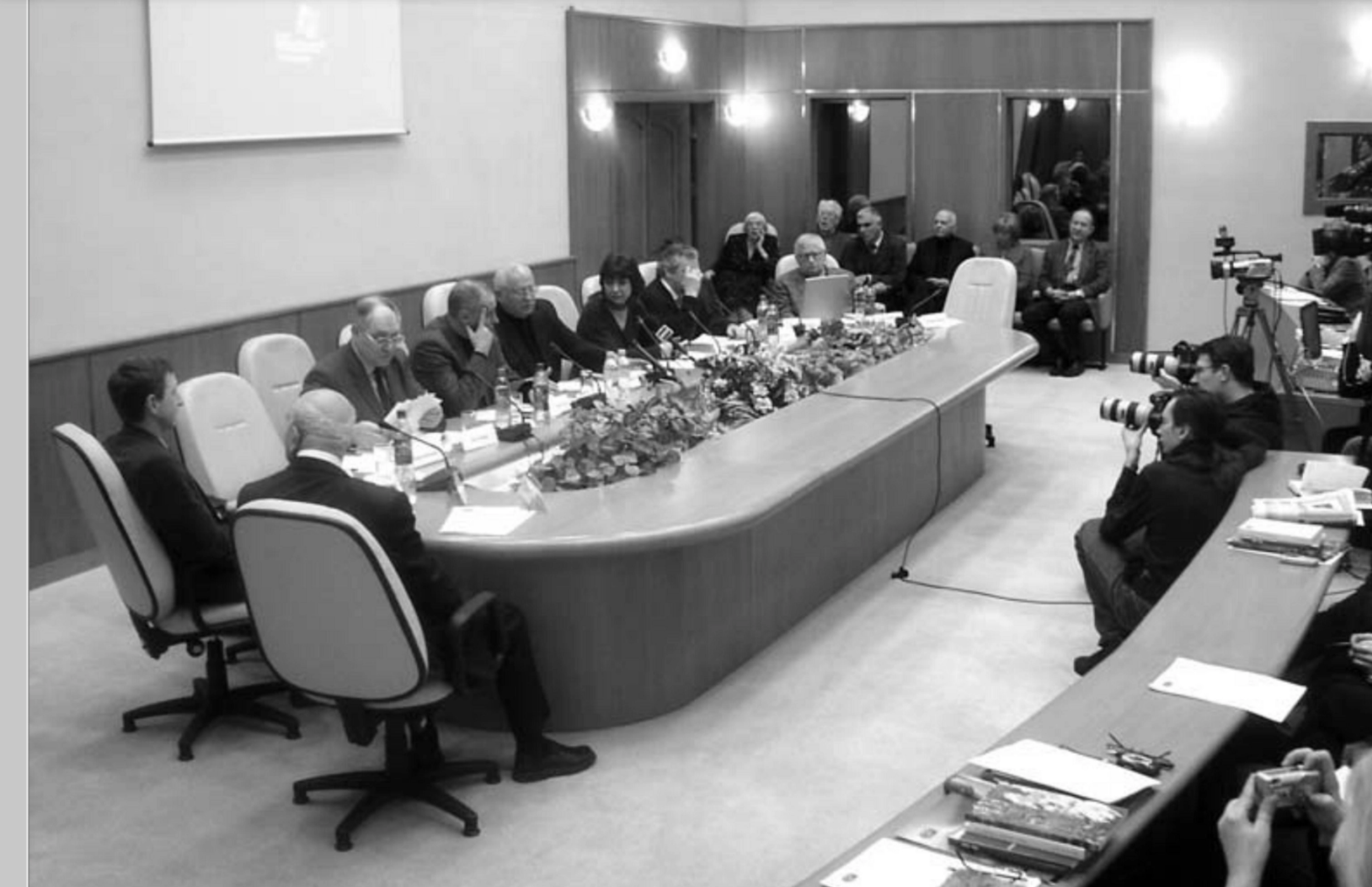51 Years of the Kennan Institute
1974
Kennan Institute Founded
The Kennan Institute was founded as a division of the Woodrow Wilson International Center for Scholars in December of 1974 through the joint initiative of Ambassador George F. Kennan, then Wilson Center Director James Billington, and historian S. Frederick Starr. Named in honor of Ambassador Kennan's relative, George Kennan "the Elder," a nineteenth century explorer of Russia and Siberia, the Kennan Institute was committed to improving American expertise and knowledge about Russia and Eurasia.
Ambassador Kennan was one of the most distinguished diplomats of the 20th Century. He relied on his intimate understanding of Russian history and culture to help shape the the strategic thinking and posture of the United States. For five decades, the Kennan Institute has followed his example by instilling knowledge in public service.
Image: Kennan Institute cofounders S. Frederick Starr, George F. Kennan, and James Billington.
1974-78
Alumni Highlights
1975 - Nikolai Bolkhovitinov (1930-2008)
Bolkhovitinov (pictured left) was a prominent historian, a pioneer of American Studies in the Soviet Union and Honorary Foreign Member of the American Historical Association. He was known as “the best Russian friend of American historians.”
1977 - Andrei Voznesensky (1933-2010)
Voznesensky (pictured right) was a modern Russian poet, an iconic figure of the Khrushchev Thaw and a member of the American Academy of Arts and Letters.
1979
Soviet Invasion of Afghanistan
In December 1979, the Soviet Union invaded Afghanistan, aiming to help a Marxist-Leninist government consolidate control amid an intensifying political crisis. The Soviet military campaign precipitated a nine-year civil war, which killed or displaced millions of Afghans and contributed to the Soviet Union’s collapse in 1991.
The Kennan Institute was an important hub of research and debate on the Soviet Union’s actions in and around Afghanistan, charting their consequences for American and international publics.
Image: A unit of Soviet soldiers pictured prior to their withdrawal from Afghanistan, 1989.
1983
Creation of Soviet-Eastern European Research and Training Act
The Soviet-Eastern Europe Research and Training Act of 1983, also known as Title VIII, was a major step forward for knowledge about the Soviet Union. The act authorized the State Department to provide grant funding for advanced research on the Soviet Union and Eastern Europe. Title VIII funding led to the creation of fellowship programs for Eastern European studies, scholar exchange programs with the Soviet Union, language training, and other research activities.
Thanks to Title VIII, The Kennan Institute was able to greatly expand its resident scholar program and to include younger scholars in the early stages of their careers. Today, in addition to approximately 900 American alumni, mainly supported by Title VIII, the Kennan Institute has over 400 alumni from Russia and over 120 from Ukraine.
Image: President Ronald Reagan delivers the State of the Union address to Congress in 1983.
1979-83
Alumni Highlights
James P. Scanlan (1927-2016)
Scanlan (center, bottom) was a Professor of Philosophy and Director of the Center for Slavic and East European Studies at Ohio State University from 1988-1991. A scholar of Tolstoy’s and Dostoevsky’s philosophical ideas, Scanlan authored more than 170 publications in English and Russian and mentored several generations of Russian philosophy students.
Vladimir Soloukhin (1924-1997)
Soloukhin (right) was a prominent writer and one of the founders of the “village prose” movement in Soviet literature, famous for nostalgic depictions of Russian nature and rural life.
James P. Scanlan (1927-2016)
Scanlan (center, bottom) was a Professor of Philosophy and Director of the Center for Slavic and East European Studies at Ohio State University from 1988-1991. A scholar of Tolstoy’s and Dostoevsky’s philosophical ideas, Scanlan authored more than 170 publications in English and Russian and mentored several generations of Russian philosophy students.
Vladimir Soloukhin (1924-1997)
Soloukhin (right) was a prominent writer and one of the founders of the “village prose” movement in Soviet literature, famous for nostalgic depictions of Russian nature and rural life.
1985
Mikhail Gorbachev Becomes Soviet Leader
On March 11, 1985, the Soviet Politburo appointed Mikhail Gorbachev the leader of the Soviet Union. Gorbachev’s tenure transformed the Soviet Union, as he sought internal reforms and a less conflictual relationship with the United States. Gorbachev’s tenure culminated in the Soviet Union’s dissolution. He remains a figure of enduring admiration in some corners and of resentment in others.
Gorbachev’s reform agenda enabled the Kennan Institute to expand its contacts within the Soviet Union and to host more scholars and experts from the country. This period helped forge new individual and institutional connections, including with President Gorbachev himself, who served as the distinguished guest speaker at the Kennan Institute’s summit on the 15th anniversary of the Russian constitution in 2009.
Image: President Ronald Reagan meets with Soviet General Secretary Gorbachev at Hofdi House during the Reykjavik Summit in Iceland on October 11, 1986.
1986
Chernobyl Disaster
Mistakes in safety testing within reactor four of the Chernobyl Nuclear Power Plant just after midnight on April 26, 1986 triggered a catastrophic meltdown, the worst nuclear incident in history. Chernobyl damaged and weakened the Soviet government, leaving a lasting scar on the topography of modern Ukraine and the collective psyche of the Ukrainian people. Chernobyl’s legacy is still unfolding. The initial phase of Russia’s February 2022 invasion of Ukraine turned the plant’s ruins into a battlefield..
The Kennan Institute hosted several discussions about Chernobyl and its portrayal in the media, such as this look at Chernobyl's role in Russia's 2022 full-scale invasion of Ukraine and a conversation with "Chernobyl" HBO miniseries creator Craig Mazin.
Image: A photo of the destroyed Chernobyl reactor taken from a helicopter several months after the explosion in 1986.
1987
Founding of Memorial Human Rights Organization
Memorial was founded in August 1987 as the Group for the Preservation of the Memory of Soviet Repression Victims, an NGO dedicated to honoring the communist regime’s millions of victims. After the fall of the Soviet Union, Memorial became a civil-society organization in post-Soviet Russia; it was dedicated to promoting democratization, human rights, and the rule of law.
In the wake of the full-scale invasion of Ukraine, Memorial was awarded the Nobel Peace Prize in 2022 - months after it was outlawed by the Russian government. Listen to the Kennan Institute's discussion about the Memorial’s destruction.
1984-88
Alumni Highlights
Karen Dawisha (1949-2018)
Dawisha (left) was a distinguished political scientist and scholar of Russia, the founding director of the Havighurst Center for Russian and Post-Soviet Studies at Miami University. She authored multiple books, including the seminal Putin’s Kleptocracy: Who Owns Russia?
1987 – Liudmila Alexeeva (1927-2018)
Alexeeva (center) was a Soviet dissident and Russian human rights activist and a founding member of the Moscow Helsinki Group. She received many awards for her work, including the French Order of the Legion of Honor, the Sakharov Prize for Freedom of Thought, and the Vaclav Havel Human Rights Prize. Human Rights Watch described her as “the doyenne of Russia’s human rights movement” and “a clear, moral voice for freedom and dignity.”
1988 – Anna Frajlich-Zając
Frajlich-Zając (right) is an award-winning poet whose “literary roots lie deep in Polish, Jewish and American culture." She is the author of 18 books of poetry, five of them bilingual, Senior Lecturer Emerita of the Department of Slavic Languages at Columbia University, and recipient of the 2017 Wybitny Polak "Distinguished Pole in the United States" award, presented by the Polish Consulate in New York.
1989
Blair A. Ruble Appointed as Kennan Institute Director
Blair Ruble began his tenure as the Kennan Institute's director in 1989. He is the longest-serving director of the Kennan Institute (1989 to 2012). Ruble’s tenure expanded scholarly exchange with the region, initiated the Institute’s program on Ukraine and sponsored research across regional university centers in Russia.
Left: Kennan Institute directors at the 25th anniversary dinner in 2001. Standing (l to r): Program Secretaries and Directors Herbert J. Ellison (1983-85); Abbott “Tom” Gleason (1980-82); Peter Reddaway (1985-88); S. Frederick Starr (1975-80); Blair A. Ruble (1989-2012); John Glad (1982-83). Seated (l to r): Amb. George F. Kennan; Russian Federation Ambassador to the United States Yuri V. Ushakov.
1989
Fall of the Berlin Wall
The wall dividing East and West Berlin was breached by peaceful protestors on the night of November 9, 1989, ending the division of a city, a country and in symbolic fashion bringing an end to the Cold War.
Image: A large crowd of people gather on November 10, 1989, to observe the construction of the new border crossing in place of the Berlin Wall.
1991
End of the Soviet Union
December 26, 1991, was the Soviet Union’s last day. The USSR had started to unravel several years earlier; Estonia, Latvia, Lithuania, and Georgia had declared their independence in 1990. On December 8, 1991, Ukrainian President Leonid Kravchuk (pictured second from left seated), Chairman of the Supreme Council of the Republic of Belarus Stanislav Shushkevich (third from left seated) and Russian President Boris Yeltsin (second from right seated) signed the Belovezh Accords to eliminate the USSR and establish the Commonwealth of Independent States. Mikhail Gorbachev resigned as leader of the Soviet Union on December 25.
1993
Kennan Institute Opens Office in Moscow, Russia
The Moscow office organized conferences and workshops, including the annual Starovoitova Readings that addressed human rights and legal developments in the Russian Federation. From 2002-2013, the Moscow office published a biannual Russian-language periodical, Vestnik of the Kennan Institute in Russia.
Image: Speakers from the Kennan Institute's Moscow office take part in a conference on Russian civil society together with the Gorbachev Foundation in 2007; Mikhail Gorbachev is seated center.
1989-93
Alumni Highlights
Audrey L. Altstadt
Altstadt (pictured far left) is a historian, professor at the University of Massachusetts Amherst, Chair of the Kennan Institute Advisory Council in 2016-2020, and author of dozens of articles on the politics, culture and history of Azerbaijan, as well as three books, including the 2017 Frustrated Democracy in Post-Soviet Azerbaijan.
Vladimir Voinovich (1932-2018)
Voinovich (center top) was a writer and dissident, stripped of his citizenship by Soviet authorities in 1981. The author of the satirical novel The Life and Extraordinary Adventures of Private Ivan Chonkin and dystopian satire Moscow 2042, he returned to the Soviet Union in 1990 and became an outspoken critic of the Putin government.
Galina Starovoitova (1946-1998)
Starovoitova (center bottom) was a prominent Russian politician and human rights advocate, a pioneer in urban anthropology whose academic research informed her public policy thinking. She co-founded the Democratic Russia movement and was called by James Billington “a leader in both the political and intellectual life of post-Soviet Russia and not just a good but also a prophetic person.”
Pilar Bonet
Bonet (right) is a Spanish journalist who spent most of her career as a Moscow-based correspondent covering developments in the region for the newspaper El País between 1984 and 2021, recipient of multiple professional awards, author of several books, including Figures in a Red Landscape (1993) on Soviet citizens at a time of dramatic change and Náufragos del imperio (Castaways of the Empire, 2023) on the war in Ukraine.
1998
Kennan Institute opens office in Kyiv, Ukraine
The Kyiv office held conferences, workshops, public lectures, book talks, and policy debates. From 2005-2017, the Kyiv office published the journal Agora on Ukrainian politics, economy, society, history, and culture. It organized Cultural Diplomacy Forums with the Foreign Ministry of Ukraine and leadership programs for internally displaced students.
Image: Participants gather in spring 2015 for a joint event with the Kennan Institute's Kyiv Office, the Fulbright Office in Ukraine, and the Center for Russian Research.
2013
Matthew Rojansky Appointed as Kennan Institute Director
Matthew Rojansky became the Kennan Institute’s director in 2013. He worked to connect the Institute’s scholars and research with the broader public and to hosted many Track II meetings. He launched the Kennan Conversations series, the Institute’s blogs and the Kennan Cable series, leading the Institute through the pandemic and the transition from in-person to online events.
2015
Russia File Blog Launch
The Kennan Institute created the Russia File blog in 2015, charting Russian foreign policy, politics, and society, with an emphasis on U.S.-Russian relations.
2017
Focus Ukraine Blog Launch
The Kennan Institute launched its Focus Ukraine blog in 2017, exploring Ukraine’s politics, history, culture, society and foreign policy.
2020
International online conference on the Status of Women in Russian Society
In July 2020, The Kennan Institute held its first fully online conference, “The Status of Women in Russian Society.” The conference report became the fifth most read publication on the entire Wilson Center website.
2022
Russia's Full-Scale Invasion of Ukraine
Russia launched its full-scale invasion of Ukraine on February 24, 2022, a decade after its annexation of Crimea. Russian President Vladimir Putin declared the attack a “special military operation," while ordering an invasion along four axes and launching missile and artillery strike on many Ukrainian cities, including Kyiv.
Image: The remains of an apartment building destroyed by Russian shelling in Kyiv, Ukraine, on February 25, 2022.
2025
An Independent Kennan Institute
In 2025, the Kennan Institute became independent, continuing its mission while moving into its new offices on 1717 K St NW. Its director is Michael Kimmage, who had been appointed director of the Kennan Institute (at the Wilson Center) in January 2025.
















